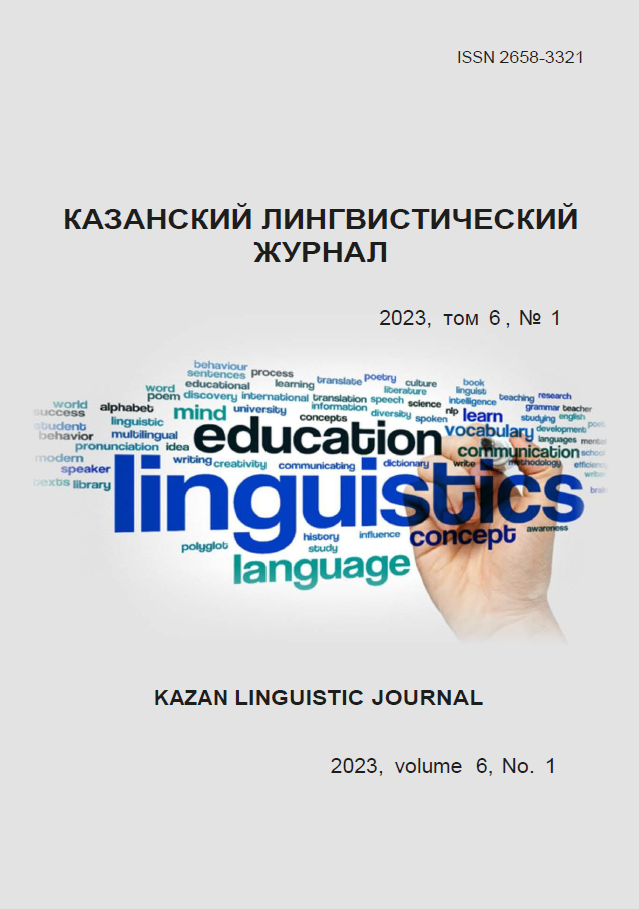Analysis of Chinese dish names with toponyms against the background of linguistic typology
https://doi.org/10.26907/2658-3321.2023.6.1.69-79
Keywords:
dish names, toponyms, linguistic typology, conceptualization, comparative analysisAbstract
The article discusses the features of the dish names with toponyms in Chinese, Japanese, English, and Italian. The relevance of the presented work lies in that the study of food culture in different countries plays an important role in intercultural communication. The aim of the work is to establish the types of such names and analyze their linguistic features, identify the cognitive mechanism of thinking and highlight the commonality in the form of expressing the dish names with toponyms between the above-mentioned languages. The names of dishes with toponyms in Chinese, Japanese, English and Italian are used as the research material. This study uses descriptive, comparative, deductive and inductive methods. In Chinese the names of dishes with toponyms, indicating the origin of the kitchen raw materials or the method of cooking are common. The factors influencing the formation of such names are divided into intralinguistic and extralinguistic. Extralinguistic factors include the structure of encyclopedic knowledge and people’s subjective attention. Intralinguistic factor includes the special tendency of bilingualization for the Chinese language. The cognitive process of the formation of these dish names includes the conceptualization and formulation of important semantic elements. We agree with the views of Cornelia Gerhardt and her co-authors, that the construction of food names with toponyms N1N2 (toponym+main kitchen ingredient/main kitchen ingredient+toponym) is common in the languages of the world. But in Chinese there are also other patterns for naming dishes: N1N2N3, N1VN2, N1AN2, N1A1A2N2, N1N2VN3, N1VAN2 and et al. It can be seen that, there is a common ground between the ways of thinking and knowledge structures of different nationalities, and on the other hand, it shows the difference between them. Chinese dishes are famous for the variety of cooking methods and the unique taste combinations.
References
References
Song Zuoyan. The characteristics of construction morphology and its enlightenment on the study of Chinese word formation:the case of the naming patterns of Chinese dishes. Lan-guage teaching and linguistic studies. 2022; (02): 88–102. (In Chinese)
Kovalyov E.D., Kozhevnikov I.R. Features of names of dishes in restaurant menus in Chinese (structural-semantic and pragmatic approaches). Filologicheskie nauki. Voprosy teorii i praktiki. 2018; 85(7–2): 329–333. (In Russ.)
Sun' Vejfan. The image of Chinese food and people in Russian tourists' comments on China. Sovremennye issledovaniya social'nyh problem. 2022; (2):126–141. (In Russ.)
Yang Youwen, Li Qin. Cultural analysis in the naming of Chinese dishes. Journal of Hubei University of Technology. 2016; 31(3): 85–88. (In Chinese)
Liu Xuanchuan. Chinese dishes translating and chinese diet culture. Journal of China Three Gorges University (Humanities & Social Sciences). 2004; (04): 75–78. (In Chinese)
Osipova K.V. On semantic and motivational reconstruction of the north Russian names of meat dishes. Vestnik Permskogo universiteta. Rossijskaya i zarubezhnaya filologiya. 2020; (3): 59–69. (In Russ.)
Nurmukhametova R.S., Minnebaeva G.I., Sattarova M.R. Ethnolinguistic study of the names of Tatar national dishes. Vestnik TSPU. 2018; 53(3):66–71. (In Russ.)
Wang Lingzhi. On the Russian translation of Chinese cuisine names. Russian in Chi-na. 2012; 31(04): 75–79. (In Chinese)
Wen Shan. A contranstive study of Chinese dishes translations between overseas Chinese and native Chinese. Chinese Science & Technology Translators Journal. 2012; 25(02). Pp.48–51+32. (In Chinese)
An Xinkui. The Application of prepositions in the translation of Chinese cuisine names. Russian in China. 2016; 35(03): 40–44. (In Chinese)
Gu Shan. A comparative study of Chinese and Western food culture in intercultural communication and its translation – A review on “the study of differences between Chinese and Western food culture and its translation”. Food & Machinery. 2021; 37(05): 238–239. (In Chinese)
Van Hejyan'. Russian translation of Chinese dish names in the aspect of transcultural communication. Vestnik KalmGU. 2018; 38(2): 88–94. (In Russ.)
Zhuang Huibin, Zhao Pusong, Feng Shengli. Diphthongization of Chinese. Beijing Language and Culture University Press; 2018. (In Chinese)
Lyu SHusyan. Introduction to Chinese Grammar. M.: Izdatel’stvo vostochnoj kul’tury. Vol.1. 1961. (In Russ.)
Langacker R.W. Dynamicity in grammar. Axiomathes. 2001; (12):7–33. (In Eng.)
Gerhardt C., Frobenius M., Ley S. (Editors). Culinary Linguistics: The chef's special. Amsterdam. Philadelphia: John Benjamins Publishing Company; 2013. (In Eng.)
Talmy L. Toward a Cognitive Semantics. Vol. I. Cambridge (Mass.); London: MIT Press; 2000. (In Eng.)
Van Cuj. Comparison of the expression of the instrumental meaning in the Russian and Chinese languages from the cognitive point of view. Izvestiya VGPU. 2018; 4(127): 131–134. (In Russ.)






